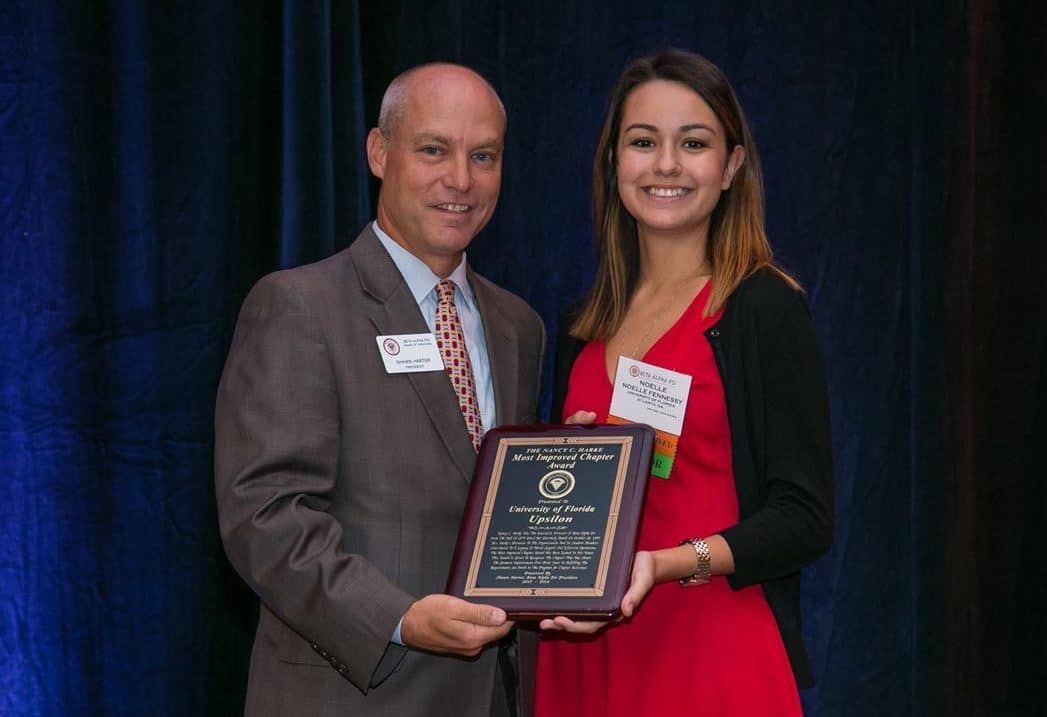Change for the better
Noelle Fennessy (BSAc ’16, MAcc ’16) came to a memorable, and somewhat sobering, realization two years ago when she attended Beta Alpha Psi’s Annual Meeting—an international gathering of the honor organization for financial information students and professionals.
“Every chapter seemed to be more active than we were,” said Fennessy, now a Staff Tax Accountant at EY in Atlanta. “Our attendance record just wasn’t that good.”
Fennessy set out to make major changes when she was appointed the chapter’s president in 2015, and the results have been nothing short of extraordinary. Fisher’s Upsilon chapter, one of more than 300 chapters around the world, received the organization’s Most Improved Chapter award at its Annual Meeting on Aug. 4-6 in Baltimore. The chapter also received a Beta Alpha Psi national sponsorship for being named a “Superior Chapter,” the organization’s highest level of recognition.
So how did Fennessy and her chapter’s leadership succeed in making such sweeping and effective changes? It’s a blueprint other Warrington student leaders could mimic to make impactful changes in their organizations.
1. Satisfy your members’ needs
The Upsilon chapter was somewhat a victim of the Fisher School’s success. A major selling point for Beta Alpha Psi chapters is the networking that leads to internships and full-time positions. But because the Fisher School’s career placement rate is already so impressive—98.3 percent for the Class of 2016—most Fisher students didn’t need Beta Alpha Psi events to obtain these sought-after positions.
So Fennessy and her team turned their attention to other aspects of the Beta Alpha Psi experience they could enhance, notably professional development and community services activities. They made speaker series events more interactive and engaging. They included more fun events like go-karting, and painting and cooking classes to attract students. They enhanced their partnership with the United Way and other local charities, and assisted in canned food drives and literacy programs for area youths among other activities.
The result was staggering: Chapter members earned 138 percent of the required hours for membership
2. Effectively communicate with members
Fennessy said there was initially a lot of pushback from members when the chapter underwent these changes. But as Fennessy articulated the need for change and how easily each member could fulfill their requirement (32 hours of professional development/community service per year), her message resonated.
To reinforce the chapter’s new direction, leadership improved its communication with members. They sent out weekly emails highlighting upcoming event and service opportunities, and enhanced their social media efforts to keep members informed. Recently, the chapter launched a new website.
3. Make personal relationships with members
To achieve buy-in, Fennessy said it was imperative to personally reach out to each member and let them know how much they were valued.
“These are the people making up your organization,” Fennessy said. “Without them, there is no organization. Make the effort to have a lasting relationship with your members.
4. Have a support group involving faculty and/or staff
Fennessy said the support offered by Dr. Jesse Boyles, Beta Alpha Psi’s faculty adviser, and Fisher School Director Dr. Gary McGill was instrumental in the chapter’s success.
“Dr. Boyles really got into it,” Fennessy said. “They knew how important this was to us, and they were our biggest cheerleaders.”
For leaders interested in major changes in their student organizations, secure buy-in from your faculty or staff advisor. Your advisor is an important ally who can play a key role in helping you implement your new vision.
5. Always be positive
This can be the toughest thing to do when attempting to change a student organization’s culture. But if leadership can maintain a positive and engaging attitude, its members should respond positively.
“I don’t think anyone thought we could do this, but I’m so proud of how everyone came together,” Fennessy said. “We did this for each other, for our chapter, and for our school.”




